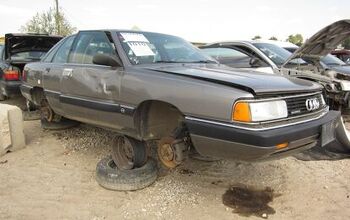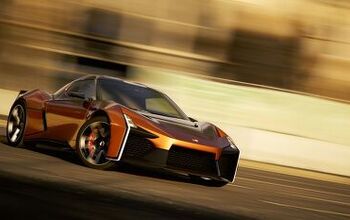Junkyard Find: 1989 Plymouth Acclaim Turbo

Members of the Plymouth Sundance/ Dodge Shadow K-Platform-based compacts of the early 1990s remain easy to find in self-service junkyards these days, but the larger stretched-K-derivative Plymouth Acclaim/Dodge Spirit isn’t so common. This probably has more to do with quantity sold than reliability, as both types are pretty similar under the skin. Here’s a first-year-of-production Acclaim Turbo, spotted in a Denver self-service yard a couple months ago.
The Taurus-inspired “bar of soap” design philosophy hadn’t caught up with Plymouth’s designers by 1989, though Chrysler would beat Ford at their own game a few years later, with the futuristic-looking LH.
153,632 miles, which is about average for junkyard-dwelling Detroit cars of this era.
You could still get a column-shift automatic on a bucket-seat-equipped midsize sedan in 1989.
The turbocharged 2.5 engine in this car made a fairly decent (for its time) 150 horsepower.
Curb weight on the ’89 Acclaim sedan was just 2,753 pounds (a little less than a 2013 Civic), so 150 horses went a long way.
Futuristic cassette-deck technology!
The white-with-red-tape-stripes scheme looks very fleet-car-ish, but rental-car companies didn’t buy many turbocharged cars back then.
Tina Turner: “You think you have to give up a lot to get Acclaim? Not when it’s a Plymouth!”

Murilee Martin is the pen name of Phil Greden, a writer who has lived in Minnesota, California, Georgia and (now) Colorado. He has toiled at copywriting, technical writing, junkmail writing, fiction writing and now automotive writing. He has owned many terrible vehicles and some good ones. He spends a great deal of time in self-service junkyards. These days, he writes for publications including Autoweek, Autoblog, Hagerty, The Truth About Cars and Capital One.
More by Murilee Martin
Latest Car Reviews
Read moreLatest Product Reviews
Read moreRecent Comments
- 3-On-The-Tree My 2009 C6 corvette in black looks great when it’s all washed and waxed but after driving down my 1.3 mile long dirt road it’s a dust magnet. I like white because dust doesn’t how up easily. Both my current 2021 Tundra and previous 2014 Ford F-150 3.5L Ecobomb are white
- Bd2 Would be sweet on a Telluride.
- Luke42 When will they release a Gladiator 4xe?I don’t care what color it is, but I do care about being able to plug it in.
- Bd2 As I have posited here numerous times; the Hyundai Pony Coupe of 1974 was the most influential sports and, later on, supercar template. This Toyota is a prime example of Hyundai's primal influence upon the design industry. Just look at the years, 1976 > 1974, so the numbers bear Hyundai out and this Toyota is the copy.
- MaintenanceCosts Two of my four cars currently have tires that have remaining tread life but 2017 date codes. Time for a tire-stravaganza pretty soon.


















































Comments
Join the conversation
I graduated HS in 1996 so that gives you a timeframe reference. Several family members had either the acclaim or spirit and they lasted a long time. I had a 95 Neon and considered trading it in on one of these used as I commuted and wanted something bigger. I drove a dozen of these models so I knew it was comfortable for a car from that era. They had some real fans out there my Grandfather had a 93. Just washed and waxed it in the summer of 1995, parked it under his deck (basement garage) The next morning my grandmother says to him where’s the car. It was gone. Her second comment was “see I was right for not letting you get rid of her old car”. She liked her 85 Caravel better and would not let him sell it. He a few weeks later got a 95 Stratus. Then found the stolen car in Philadelphia about 90 minutes away sitting in a tow lot torched. Insurance already paid himHe did miss his Acclaim though and eventually the stratus As My grandmother on the other hand gave him the Caravel as she preferred the new one. He drove the caravel till 1997
We drove these cars for drivers ed in high school!